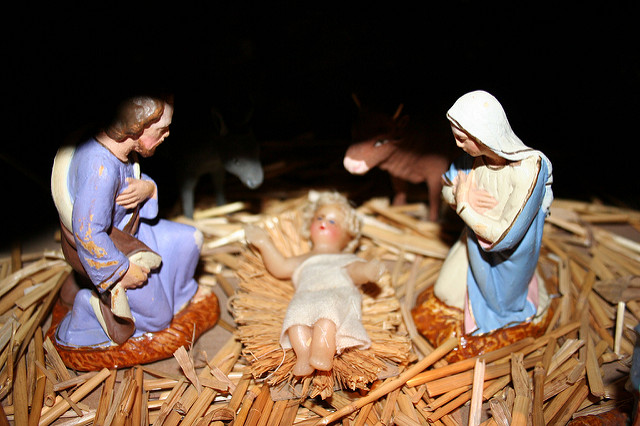2018 Theme Issue: Keepsakes

I grew up with Christmas Done Right, although my mother would occasionally sigh and roll her eyes at what she called “all this standing on ceremony.” Outside decorations went up on the second Sunday of Advent. Our tree appeared just a few days before Christmas because my father had an insurance agent’s fear of dry trees bursting into flames if left too long in the house. Stockings were hung after a reading of ‘Twas the Night Before Christmas. Attendance at midnight church was mandatory as was candlelit dinner the next day, served on heirloom china, preceded by old-fashioneds and scotch highballs sipped from crystal glassware. Pajamas were acceptable for morning gift-opening, but after that we wore coats and ties and velvet dresses and moved through the day accompanied by background music from the Mormon Tabernacle Choir or the latest Firestone Christmas album.
We were staunch Episcopalians, so church and nativity scenes were at the center of our celebration. The manger we had in our home came from Woolworth’s, that small-town emporium smelling of plastic and slightly fetid water from the fish and turtle tank in the back, and where all your purchases were rung up by gum-chewing middle-aged women named Judy or Marge. I remember my mother and I choosing that set from the seasonal aisle in the center of the store where it was displayed among orange-bulbed window candles and shiny aluminum trees complete with their own rotating colored light reflector.
I still set up that same creche on a shelf in our family room even though some of the lambs are amputees and the cardboard stable, with its roof covered in coconut-like shavings, fell apart years ago. Price tags that say 29 cents remain adhered to the bottom of some of the figures. It is the creche of my childhood, the one under which I hung my stocking, the one pictured in a rare candid snapshot of my parents sitting on the hearth with their heads together, laughing.
The good creche belonged to my grandparents and was displayed on the mantel in the front room of their home, a stately mansion built in 1795 near the river in the oldest part of town. The room my grandmother referred to as the hall was graced with a grand piano, miserably uncomfortable Victorian furniture, and a fireplace big enough to support two small arborvitae shrubs in gigantic pots placed there every Christmas by Fig, their handyman.
Like many of the genteel ladies of her day, my grandmother did ceramics. She hand-painted each figure in their manger set in exquisite detail, dedicating countless hours of tedious work to create a gift for my grandfather who built the stable in his spare time when he wasn’t busy healing the sick and the injured. His simple wooden box, finished in a dark brown lacquer, is as solid and unblemished today as it was that first Christmas it appeared on their mantel. Not a loose nail or a splinter anywhere. Inscribed on the bottom of each piece are their initials, “ALD to JDD, 1958” like teenage lovers’ names carved on a tree.
On Christmas Eve, I would walk a block down the street to their home, remove the baby Jesus from his bed of tissue paper in a Carolina Soap box, and gently place him in the manger, followed by my grandparents and I standing together in front of the fireplace singing “O Little Town of Bethlehem.” We were great proponents of liturgical correctness, so the baby never arrived in the manger before Christmas Eve, and the Magi were always placed approaching from the east.
After my grandparents passed away, my father inherited the good creche. He set it up by himself for years and then gradually, when pulling boxes from the cupboard beside the stairs became too much for him, he insisted that I do it, arranging the figures in the same place as its Woolworth’s predecessor. Ten years ago, it came to me. I, who spoke with dry-eyed eloquence at my father’s funeral, wept the first time I placed Mary and Joseph in that stable on my grandmother’s desk, now in my own living room.
Every December, when I unwrap each piece from its nest of newspaper, I marvel at the rich purple colors of the kings’ robes, the almost lifelike eyes of the human figures, the wonder on the face of the kneeling shepherd boy who has earned a place of honor inside the stable itself. I run my hands over the texture of the saddle on the camel, the pointed wings of the angel with her “Gloria in Excelsis” banner, the empty indentation of the manger bed, waiting for its holy occupant. I place that same soap box with the words “Baby Jesus” scrawled on the lid in my grandmother’s handwriting, into a cubby of her desk where it waits during the dark weeks of Advent.
I picture my grandmother, in her second-floor ceramics room, filled with paint-spattered card tables, crumpled rags, and brushes soaking in peanut butter jars. She’s sitting there in her smock, deciding on the colors, using that miniscule brush to outline the eyes of the figures and the words on the angel’s banner, applying the extra coat of glaze to give a sheen to the animals’ coats.
I think of my grandfather, puttering in his basement workshop after a long day of seeing patients, the hands that probe gently for pain and deliver babies, now selecting just the right pieces of wood, cutting, and sanding and nailing them together with a surgeon’s precision to create a perfect miniature stable. I think of the joy and pride they must have felt on Christmas Eve 1958, seeing their gift honoring God and each other, displayed for the first time between those two miniature evergreen trees above their fireplace.
In the yearly ritual of assembling the good creche, I feel the presence of those who celebrated Christmas with me as a child. Their hands guide me as I unfold and smooth the green fabric that goes under the stable, position the light to shine directly down on the manger bed, and make sure the angel is properly anchored on her little hook. In the good creche, I smell pine branches and wood smoke from the fireplace as I walk into my grandparents’ home on Christmas Eve, wearing my new velvet dress with the pink rose, ready for my first ever midnight mass. I taste the eggnog sprinkled with nutmeg in my grandmother’s antique crystal punch cup. I hear my grandfather’s slightly off-key singing and years later, my dad’s weakened voice on the phone, asking when I’m going to stop by and set up the manger for him.
Sometimes I think about what will happen to the good creche when I am gone. We have no children or nieces and nephews. Unless I bequeath it to my godchild or designate it for the church, it will probably end up at an auction house, just another interesting antique Christmas decoration for someone’s home. The new owner may glance at the bottom of the pieces and wonder whose initials they are. No one will wax nostalgic about my hands helping them arrange the figures or remember how beautiful it looked on the desk in my living room. This creche is simply a collection of clay figures housed in a wooden box, and I am the last person alive for whom it has any value beyond the aesthetic.
I discover that the older I get, the more I need to touch the objects people I loved once touched—to wrap my arms around the tangible evidence that they once existed as the memories of their physical presence gradually recede. The boxes of family slides buried on a closet shelf. The ceramic pitchers my grandmother painted that hold my kitchen utensils. My father’s Book of Common Prayer, covered in nubby leather and inscribed on his 1937 confirmation day, resting in my nightstand drawer.
I spend my Christmas Eves now surrounded by people for whom the good creche is simply a beautiful decoration. My husband’s family is a somewhat restrained crowd so there is no ceremonial placement of the baby in the manger accompanied by fervent carol-singing. We arrive home from midnight church each year and make small talk about the service and what time to have dinner the next day. I pour cups of eggnog spiked with rum and set out plates of homemade cookies. Tomorrow I will serve beef tenderloin in a candlelit dining room, eaten with knives and forks engraved with my great-grandparents’ initials. We will sip wine from antique goblets as gorgeous choral music wafts through the house. I no longer wear velvet dresses, but I still believe in Christmas Done Right.
After everyone has gone to bed on Christmas Eve, I walk into the living room, illuminated only by window candles and the lights surrounding the good creche. My grandparents smile back at me from a picture on top of the desk as I reach into the cubby and pull out the Carolina Soap box. I remove the baby from its tissue paper womb, and my hands, now speckled with age spots, once again place the holy infant in the manger as I quietly sing “O Little Town of Bethlehem.”
 Anne Moul is a retired music educator who is now happily pursuing her second act as a writer of personal essays and creative nonfiction. She has had essays published and pending in Episcopal Café and the Pennsylvania Music Educators News and recently won first place for nonfiction in the 2018 Pennwriters writing contest. She blogs at www.secondactstories.com and lives in south-central Pennsylvania with her husband Brian and a houseful of high maintenance pets.
Anne Moul is a retired music educator who is now happily pursuing her second act as a writer of personal essays and creative nonfiction. She has had essays published and pending in Episcopal Café and the Pennsylvania Music Educators News and recently won first place for nonfiction in the 2018 Pennwriters writing contest. She blogs at www.secondactstories.com and lives in south-central Pennsylvania with her husband Brian and a houseful of high maintenance pets.
STORY IMAGE CREDIT: Flickr Creative Commons/Titem


